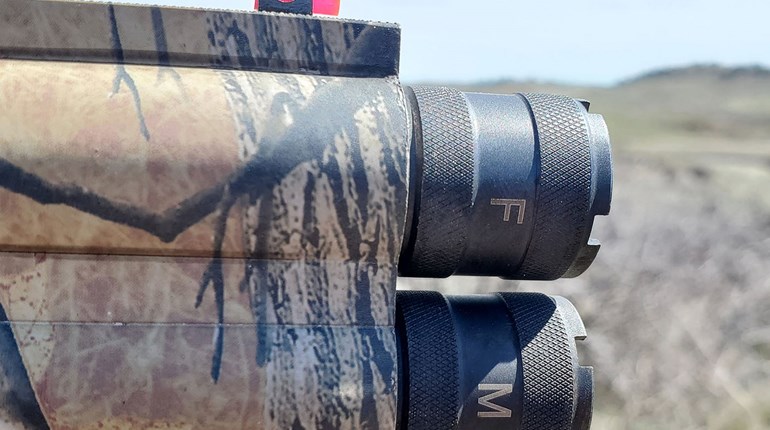
I was taking a Team Tactics course at Gunsite Academy with a friend. We were preparing to walk into a shoot-house and were armed with Simunition training handguns in holsters. “OK, the two of you are on a fun road trip and you’re stopping at a gas station for snacks,” instructor Mario Marchman said to set up the scenario.
So she and I entered the “gas station” shoot-house, greeted a few “casual shoppers” on our way through, and walked to the back left corner, not far from the cashier. Before we knew what was happening, a guy (an instructor playing the role of bad guy) started mugging the cashier, so we drew our guns and started looking for a way to escape, only to find ourselves being shot at by a second bad guy we had barely even noticed. Fail.
Afterward, the instructor walked us through what had happened and what we could have done differently. “Why did you both walk to the same corner of the store?” he asked. Flummoxed, I naively answered, “I dunno, maybe that’s where the Coke machine was and we both wanted a soda?” He went on to explain that a better plan would have been for us to split up and walk to different parts of the store. “Do you really do that when you’re road tripping with a friend? Do you think of stuff like that?” I replied. “I guess I just don’t live my life that way.”
My problem? I had been somewhere between Condition White and Condition Yellow, and my partner and I had both failed to make the jump to Condition Orange.
If you’re not familiar with Jeff Cooper’s “Color Code” system, it’s a way of explaining different levels of situational awareness. The code starts with white and escalates to red, as follows:
- Condition White: You are totally oblivious to your surroundings, consumed with whatever you’re doing, paying no attention to what’s going on around you.
- Condition Yellow: You’re relaxed, but alert. You’re not worried about anything, but you’re aware of what’s happening around you and are casually scanning your environment.
- Condition Orange: You’ve taken note of something that might be a potential problem and you’re keeping an eye on it.
- Condition Red: That potential problem has turned into an actual, active threat and you are prepared to take immediate action to mitigate it.
Most people live their lives in Condition White and a mild version of Condition Yellow. They listen to their headphones or scroll through their phone or mentally plan their grocery list while they’re walking down the street. Self-defense-minded people, especially concealed carriers, should be in serious Condition Yellow when in public, staying aware of what’s going on around us and noting who and what is moving in and out of our space.
I entered that shoot-house in what I thought was Condition Yellow, because I knew something was about to go down, I just didn’t know what. When I noticed a “shopper” standing away from the register casually reading a magazine—unusual behavior for a convenience store—it didn’t pop into my head that hey, that’s weird, maybe I should keep that guy on my radar. That guy acting in a way that didn’t fit the setting should have flipped me to Condition Orange, but it didn’t. Does that mean my Condition Yellow needs work? Probably. The other thing I failed to realize was that our behavior of staying together was very Condition White—but also very normal.
As I asked the instructor, does anyone really live that way? Now, granted, the shoot-house scenario was designed to make us fail to learn lessons—that’s the point of training. But doesn’t it seem that two buddies on a road trip would be downright paranoid to make a plan about entering a gas station to buy snacks? To me, that might be taking Condition Yellow a step too far.
Which leads to the big question: How practical is it to live in serious Condition Yellow? In a world where most people are walking around in Condition White, how do we strike a balance between paranoia and safety?
First, we have to acknowledge that we all zone out sometimes, and that’s practically unavoidable. Anyone who claims to be in Condition Yellow 100 percent of the time is fooling themselves. But we should strive for a certain level of awareness at all times as much as we’re able, taking notice of what’s around us and mentally categorizing people and situations as threat or no threat. The trick is to keep that super casual so you don’t spend all your time and energy scanning the landscape for problems. When you’re driving a car, you’re glancing around you to note what other cars are in proximity to yours and how fast they’re going, etc., but you’re not concerned about any of them. This is ideal Condition Yellow. You aren’t worried until you see a driver weaving in and out of traffic ahead or a deer standing 10 yards off the side of the road. This isn’t a problem for you yet, but it certainly could become one pretty quickly. Now you’re in Condition Orange ready to spring into Condition Red.
The trick to living in Condition Yellow without becoming paranoid is to know what threats look like—you’re pretty intuitive at this already, but a huge red flag is behavior that doesn’t fit the scenario. That might be a guy reading in a convenience store, a single person loitering in a parking lot, or anything else that just feels “off.” It’s also helpful to educate yourself a bit on what typically are not threats. That guy who gets on the elevator two floors below you and rides it down to the parking garage? Probably not a threat (he wasn’t following you; it’s logical that you’re both leaving the building and going to the same place—the garage). That guy who is lingering by the elevator and starts following you when you get off in the garage alone? Definitely a potential threat (who lingers by an elevator in parking garage unless they have ill intent?). I’ve found the book “The Gift of Fear” by Gavin de Becker life-changing in helping me manage and categorize threats. (Disclaimer: there are some vague anti-gun undertones in the book that you should absolutely ignore or take with a grain of salt.)
You can also make Condition Yellow easier and more natural by picking up a few simple habits.
- Choosing a seat where you can see the entrance (preferably with your back to the wall) allows you to keep an eye on who’s coming and going and will let you spot potential threats more easily.
- Avoiding headphones and phone calls when you’re in public will keep you in-the-moment and more able to notice problems from afar.
- Looking people in the eye and greeting them with a smile, a hello or a simple head nod forces you to pay attention to who’s in the room and also lets them know they’ve been seen. I live in the South, where it’s common to greet every person you pass, so this is normal for me. It might be considered weird or awkward where you’re from, so maybe stick to simple eye contact and a head nod if that’s the case.
After the Team Tactics course wrapped up, the instructor brought my “I don’t live my life that way” comment up to the class. “That’s a fair point,” he acknowledged. “Most people don’t. It’s a decision you have to weigh for yourself as to what level of caution is right for you.” And that’s the key. You can live your life in Condition Yellow with a few simple habits and a clear understanding of what exactly that level of awareness means to you.














































